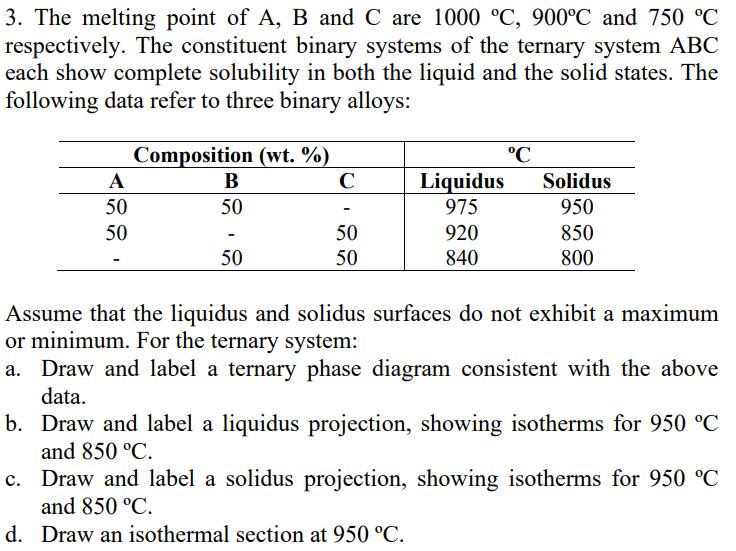a. Draw and label a ternary phase diagram consistent with the above data. b. Draw and label a liquidus projection, showing isotherms for 950 °C and 850 °C. c. Draw and label a solidus projection, showing isotherms for 950 °C and 850 °C.
a. Draw and label a ternary phase diagram consistent with the above data. b. Draw and label a liquidus projection, showing isotherms for 950 °C and 850 °C. c. Draw and label a solidus projection, showing isotherms for 950 °C and 850 °C.
Introduction to Chemical Engineering Thermodynamics
8th Edition
ISBN:9781259696527
Author:J.M. Smith Termodinamica en ingenieria quimica, Hendrick C Van Ness, Michael Abbott, Mark Swihart
Publisher:J.M. Smith Termodinamica en ingenieria quimica, Hendrick C Van Ness, Michael Abbott, Mark Swihart
Chapter1: Introduction
Section: Chapter Questions
Problem 1.1P
Related questions
Question

Transcribed Image Text:3. The melting point of A, B and C are 1000 °C, 900°C and 750 °C
respectively. The constituent binary systems of the ternary system ABC
each show complete solubility in both the liquid and the solid states. The
following data refer to three binary alloys:
Composition (wt. %)
°C
A
В
C
Liquidus
975
Solidus
50
50
950
50
50
920
850
50
50
840
800
Assume that the liquidus and solidus surfaces do not exhibit a maximum
or minimum. For the ternary system:
Draw and label a ternary phase diagram consistent with the above
data.
b. Draw and label a liquidus projection, showing isotherms for 950 °C
and 850 °C.
c. Draw and label a solidus projection, showing isotherms for 950 °C
and 850 °C.
d. Draw an isothermal section at 950 °C.
Expert Solution
This question has been solved!
Explore an expertly crafted, step-by-step solution for a thorough understanding of key concepts.
Step by step
Solved in 2 steps with 4 images

Recommended textbooks for you

Introduction to Chemical Engineering Thermodynami…
Chemical Engineering
ISBN:
9781259696527
Author:
J.M. Smith Termodinamica en ingenieria quimica, Hendrick C Van Ness, Michael Abbott, Mark Swihart
Publisher:
McGraw-Hill Education

Elementary Principles of Chemical Processes, Bind…
Chemical Engineering
ISBN:
9781118431221
Author:
Richard M. Felder, Ronald W. Rousseau, Lisa G. Bullard
Publisher:
WILEY

Elements of Chemical Reaction Engineering (5th Ed…
Chemical Engineering
ISBN:
9780133887518
Author:
H. Scott Fogler
Publisher:
Prentice Hall

Introduction to Chemical Engineering Thermodynami…
Chemical Engineering
ISBN:
9781259696527
Author:
J.M. Smith Termodinamica en ingenieria quimica, Hendrick C Van Ness, Michael Abbott, Mark Swihart
Publisher:
McGraw-Hill Education

Elementary Principles of Chemical Processes, Bind…
Chemical Engineering
ISBN:
9781118431221
Author:
Richard M. Felder, Ronald W. Rousseau, Lisa G. Bullard
Publisher:
WILEY

Elements of Chemical Reaction Engineering (5th Ed…
Chemical Engineering
ISBN:
9780133887518
Author:
H. Scott Fogler
Publisher:
Prentice Hall


Industrial Plastics: Theory and Applications
Chemical Engineering
ISBN:
9781285061238
Author:
Lokensgard, Erik
Publisher:
Delmar Cengage Learning

Unit Operations of Chemical Engineering
Chemical Engineering
ISBN:
9780072848236
Author:
Warren McCabe, Julian C. Smith, Peter Harriott
Publisher:
McGraw-Hill Companies, The